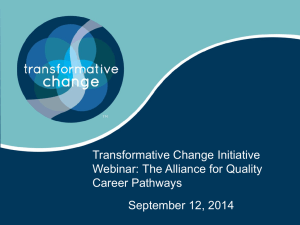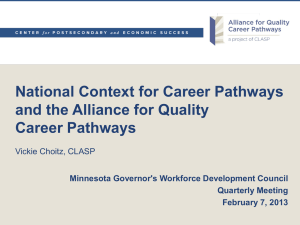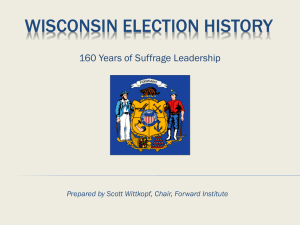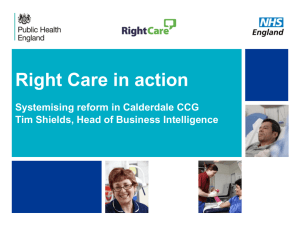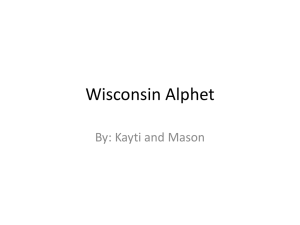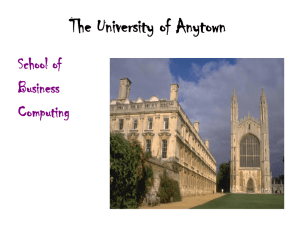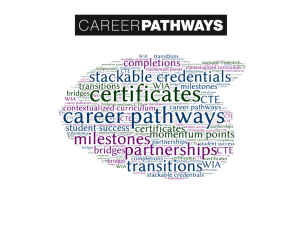Taking Career Pathways to Scale
advertisement
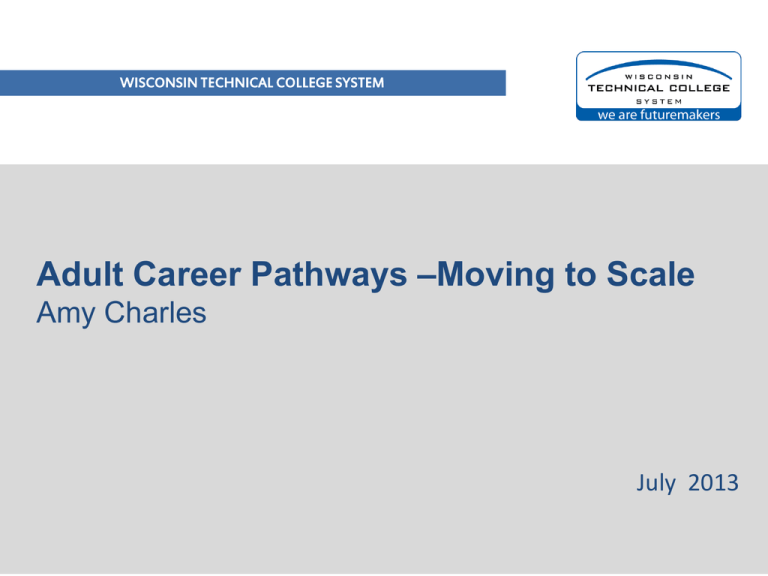
WISCONSIN TECHNICAL COLLEGE SYSTEM Adult Career Pathways –Moving to Scale Amy Charles July 2013 Challenges Employers Want Skills • • Ninety percent of employers in manufacturing, regardless of company size, industry, or location, face a moderate to severe shortage of qualified skilled production employees, such as machinists and technicians. More than half of the employers surveyed by the U.S. Chamber of Commerce considered it hard or very hard to find qualified workers to fill job openings, even in the midst of a slow economy. Workers Need Skills • • • In the US, over the last generation, pay-off to college has grown substantially. Wisconsinites with college degrees have seen wages increase steadily; those with less education are falling behind. Washington identified the Tipping Point – a year of post-secondary education culminating in a credential WISCONSIN TECHNICAL COLLEGE SYSTEM Tomorrow’s Workforce WISCONSIN TECHNICAL COLLEGE SYSTEM Origins Preliminary Work • Center for Law and Social Policy (CLASP) • Madison Area Technical College • Workforce Development Board of South Central Wisconsin Joyce Foundation’s Shifting Gears • Regional Industry Skills Education • Goal: Increase the number of adults who earn postsecondary occupational credentials • Strategy: Adult Career Pathways and Bridges • Target: 700,000 adults, without a credential beyond high school, in the workforce and making less than the median wage WISCONSIN TECHNICAL COLLEGE SYSTEM Adult Career Pathways – Basic Concept Education Industry With Jobs Skilled Topdarkgreen LtGrnRect TopMed Degree GrnRect or Bottom Diploma MedGrn Bridge Rect High School or Less For workers: • Predictable path to job advancement and higher wages • More employer support; easier access to education • More security WISCONSIN TECHNICAL COLLEGE SYSTEM Credentials ? MedGrnTrap LtGreenTrap Low Skill For employers: • Larger pool of qualified workers • Better pipeline to fill skilled jobs from within • Higher retention, employee loyalty Critical Components Post-secondary Occupational Education Support Services 6 WISCONSIN TECHNICAL COLLEGE SYSTEM Adult Basic Education/ELL An Entry Point for All Learners A Career Pathway Bridge helps adults in need of basic skills or English Language Learning succeed in a Career Pathway by integrating basic skills development into the college-level coursework of the first credential or credentials of an established Career Pathway. Career Pathway Bridges accelerate students’ transition from pre-college to college level work and help them complete credentials. WISCONSIN TECHNICAL COLLEGE SYSTEM Nicolet Area Technical College Gas Arc Welding The credits in the certificate below, plus: Welding Technical Diploma (31-442-1) 29 credits Gas Metal Arc Welding Certificate (30-442-2) 15 credits (plus Integrated and team-taught ABE for students who benefit from this instructional approach) Destructive & Nondestructive Testing – 1 Cr. Shielded Metal Arc Welding – 2 Cr. Oxyfuel & Arc Cutting Processes – 2 Cr. Flux Cored Arc Welding – 3 Cr. Gas Tungsten Arc Welding – 5 Cr. Customer Relations – 1 Cr. Basic Blueprint Reading – 4 Cr. Safety in Welding – 1 Cr. Metallurgy Fundamentals - 2 Cr. Gas Metal Arc Welding – 4 Cr. Applied Tech Math – 2 Cr. Applied Comm -- 2 Cr. Continued instructional and student support services as needed Integrated ABE Courses • Basic Reading Skills for Welders -- 1 • cr. • Basic Math Skills for Welders -- 1 cr. • Basic Communications Skills for Welders -- 1 cr. ABE and ELL Instruction and Skill-Building Efforts to date • Established the need for Adult Career Pathways • Created definitions to anchor efforts • Established local base of support in colleges and workforce programs • Created a data set to support new analyses of adult learning trajectories and outcomes • Implemented a communications plan • Conducted data analysis of Pipeline data, created data storyline and began to report results • Participated in multiple national efforts related to Adult Career Pathways– Including AQCP (Association for Quality Career Pathways) a 10-state initiative to create benchmarks for quality career pathways measurement. WISCONSIN TECHNICAL COLLEGE SYSTEM Taking Career Pathways to Scale Expand Adult Career Pathways, including Adult Career Pathway Bridges, so they are offered in every technical college district and cover all major industry sectors and occupational clusters WISCONSIN TECHNICAL COLLEGE SYSTEM Coordinated Development WISCONSIN TECHNICAL COLLEGE SYSTEM Taking Career Pathways to Scale Integrate ongoing Career Pathway work with sector efforts driven by Wisconsin Economic Development Corporation (WEDC) and the Department of Workforce Development (DWD) • See Sectors for your region at: http://inwisconsin.com/economicfuturestudy/ WISCONSIN TECHNICAL COLLEGE SYSTEM Partnering with the Workforce System • All 11 Workforce Development Boards (WDB) are convening local Employment and Training partners Directory of Adult Career Pathways and Bridges – New website and Career Pathway Roadmap tool • Job Centers – Re-structured services and staff to orient clients to Adult Career Pathways • Clients meet with career advisors during first visits • Assigned staff have become “industry experts” to bring industry-specific knowledge to the Job Centers WISCONSIN TECHNICAL COLLEGE SYSTEM Taking Career Pathways to Scale Expand pipeline data system to allow us to measure outcomes related to Adult Career Pathways and Adult Career Pathway Bridges, and continue to influence decisions on policy and program priorities. WISCONSIN TECHNICAL COLLEGE SYSTEM Data Pipeline Study: Then and Now • Initial RISE review of Data Pipeline Study • ABE is a small but significant feeder to postsecondary programs. • ABE students who go on to PS programs are about as successful as those who start at college level. • ELL students enroll in PS courses at very low rates. The ones who do, perform well. • Program enrollment makes a big, positive difference for all groups in terms of earning college credits. • Next steps • What specific services and/or instructional practices are necessary for success in an Adult Career Pathway? • How are an individual's wages improved by participation in an Adult Career Pathway? • What is the ROI for students? Programs? Colleges? WISCONSIN TECHNICAL COLLEGE SYSTEM Taking Career Pathways to Scale Support Career Pathway implementation with a mix of public and private funding streams through state‐level program policies and collaboration among local partners. WISCONSIN TECHNICAL COLLEGE SYSTEM Overview of Current Career Pathway Activities • • • • US Department of Labor Grants – Workforce Innovation Fund • Skills Wisconsin • Various sectors – TAACCT Grant – Round 2 • Making the Future • Manufacturing focus – TAACCT Grant – Round 3 • INTERFACE • IT/Computer Skills focus CLASP – Alliance for Quality Career Pathways Initiative Jobs for the Future – Accelerating Opportunity Initial discussions with philanthropic entities – Incourage and the Greater Milwaukee Foundation WISCONSIN TECHNICAL COLLEGE SYSTEM Next Steps • Further Integration of Student Services and Instructional Delivery • Data-Driven Decisions • Defining the linkage to Performance-Based Funding • Continued Communication and Outreach WISCONSIN TECHNICAL COLLEGE SYSTEM Career Pathways Concerns • Capacity issues- students, class space and enrollment management issues • Need more employer involvement to create pathway opportunities • Funding strategies-Issues with Financial Aid • $$$$ • Lack of consistent language state-wide • Willingness to fund programs collaboratively across agencies. • Concern over Adult and Youth Career Pathways WISCONSIN TECHNICAL COLLEGE SYSTEM



